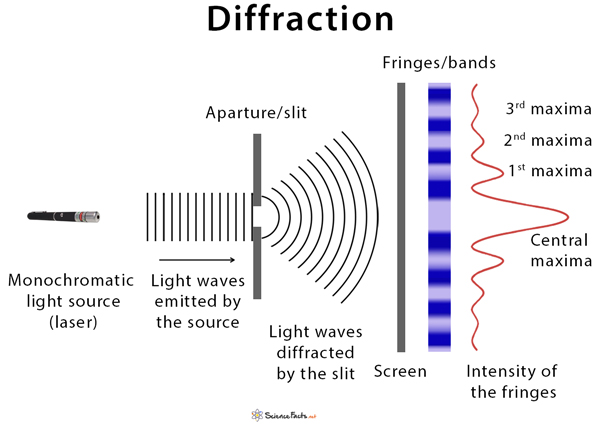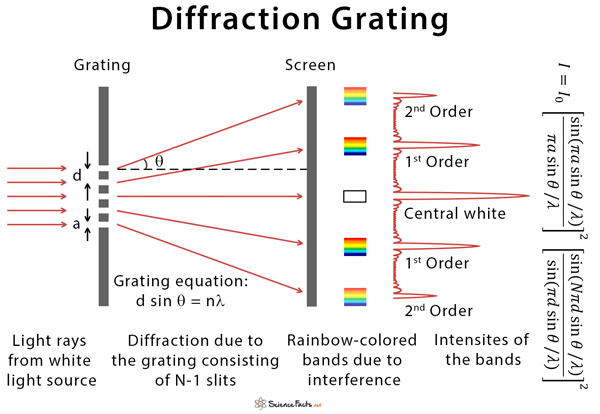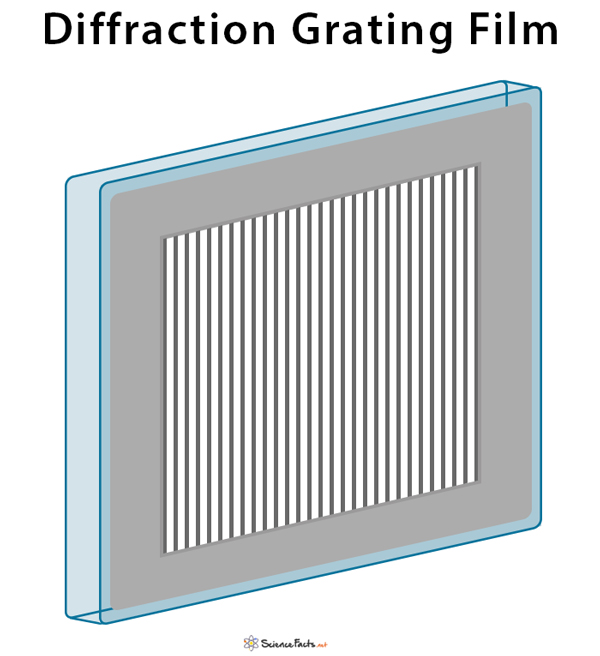Diffraction
What is Diffraction?
Diffraction is the bending or spreading of light waves around an obstacle. The obstacle can be an aperture or slit whose size is approximately the same as the wavelength of light. The amount of bending depends on the relative size of the opening compared to the wavelength of light. The bending will be almost unnoticeable if the opening is much larger than the wavelength. Due to diffraction, the direction of waves changes as they pass around an obstacle in their path.
According to Huygens’ principle, the aperture or slit diffracting the waves becomes the secondary source of waves. The diffracted waves fall a screen and form a pattern known as a diffraction pattern. It consists of alternating dark and bright fringes spread across the screen. A bright central fringe is observed at the center, surrounded by several maxima and minima. Diffraction experiments have shown that light has wavelike properties.
Diffraction experiments can be performed with one slit (single-slit diffraction), two slits (double-slit diffraction), or multiple slits (diffraction grating). There are two types of diffraction: Fresnel diffraction and Fraunhofer diffraction.
The history of diffraction goes back to 1660 when Italian mathematician and physicist Francesco Maria Grimaldi observed it for the first time and subsequently coined the term.
Examples and Applications of Diffraction
- An example of diffraction is seen in the atmosphere. Diffracted light bends around atmospheric particles like tiny water droplets that are present in clouds producing light and dark fringes or colored bands. The diffraction of sunlight by clouds is a common phenomenon referred to as a silver lining.
- Another example of diffraction is while observing the back of a compact disc (CD). Recorded data on CD is stored in tiny pits of different lengths, which carry the information. These pits have the same width and are equally spaced in a row, forming a diffraction grating on the CD mirror surface.
- Hologram projection is also an example of diffraction. When two propagating waves cross each other’s path, they create a standing wave. This standing wave, which remains still, can be photographed. By using two different waves of light, a standing wave is created and photographed, resulting in a hologram.
- The appearance of the sun during sunrise and sunset is due to diffraction. The sun appears red because light gets diffracted in the presence of dust particles in the atmosphere. Also, when sunlight passes through trees, they are diffracted because trees are obstacles in the path of sunlight.
- Other examples of diffraction include lights through a shadow of an object and the bending of light at the corners of the door.
Image Courtesy: Satyam Bhuyan
Diffraction Grating
A diffraction grating is a multi-slit surface with a periodic structure that splits and diffracts light into several beams traveling in different directions. It consists of many parallel closely-spaced slits with the spacings of the order of the wavelength of light. The role of diffraction grating is to separate a polychromatic light into its constituent wavelengths or colors. The polychromatic light is incident on the grating and dispersed so that each wavelength bends at a slightly different angle from the other. A pattern of rainbow fringes appears on the screen, with the color fading as they move away from the center.
The condition for maximum intensity is the same as that of the double-slit or multiple-slits. However, with many slits, the intensity maximum is very sharp and narrow, providing a high resolution for spectroscopic applications. As a result, the peak intensities are much higher for the grating than for the double slit.
Gratings are generally better than prisms as they are more efficient and provide a linear dispersion of wavelengths. The incident light does not suffer absorption that is observed in prisms, which limits their wavelength range.
Diffraction vs. Interference
| Diffraction | Interference |
| Secondary wavelets originating from different parts of the same wavefront | Consist of two separate wavefronts originating from two coherent sources |
| Region of minimum intensity is not perfectly dark | Region of minimum intensity is perfectly dark |
| Width of the fringes are never equal | Width of the fringes may or may not be equal |
| Some variation can be seen in the intensities of the maxima | All the maxima are of the same intensity |
| Can be produced with a single slit, double slit, or multiple slits (grating) | Requires two narrow slits to produce |
Diffraction vs. Scattering
| Diffraction | Scattering |
| Particular case of scattering involving waves | General phenomenon involving both waves and particles |
| Bending of waves by sharp objects | Deflection of waves and particles by smaller particles, called scatterers |
| Object that bends waves must be smooth and regular on a length scale equal to the wavelength | Surface that scatters waves is rough on the length scale of the wavelength of light |
| Coherent process | Coherent or incoherent process depending upon the interacting surface |
| Does not necessarily change the wavelength of light but disperses white light into its constituent colors | May change the wavelength of light, like Raman scattering |
Article was last reviewed on Thursday, November 17, 2022











